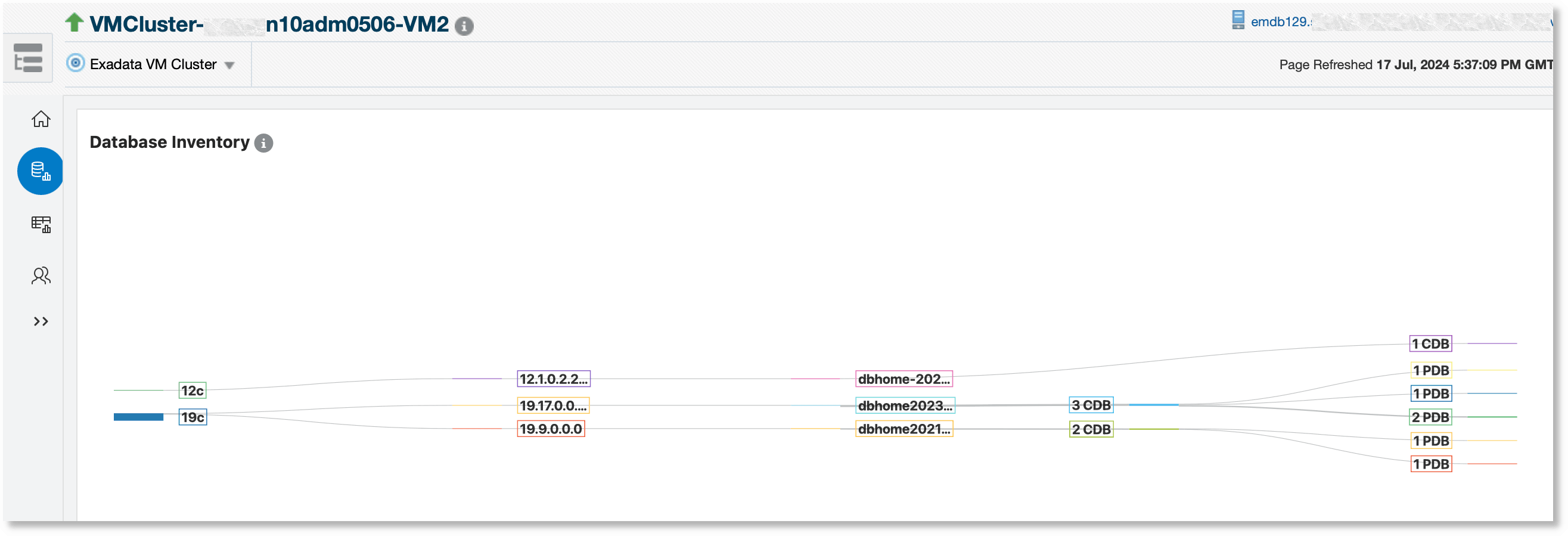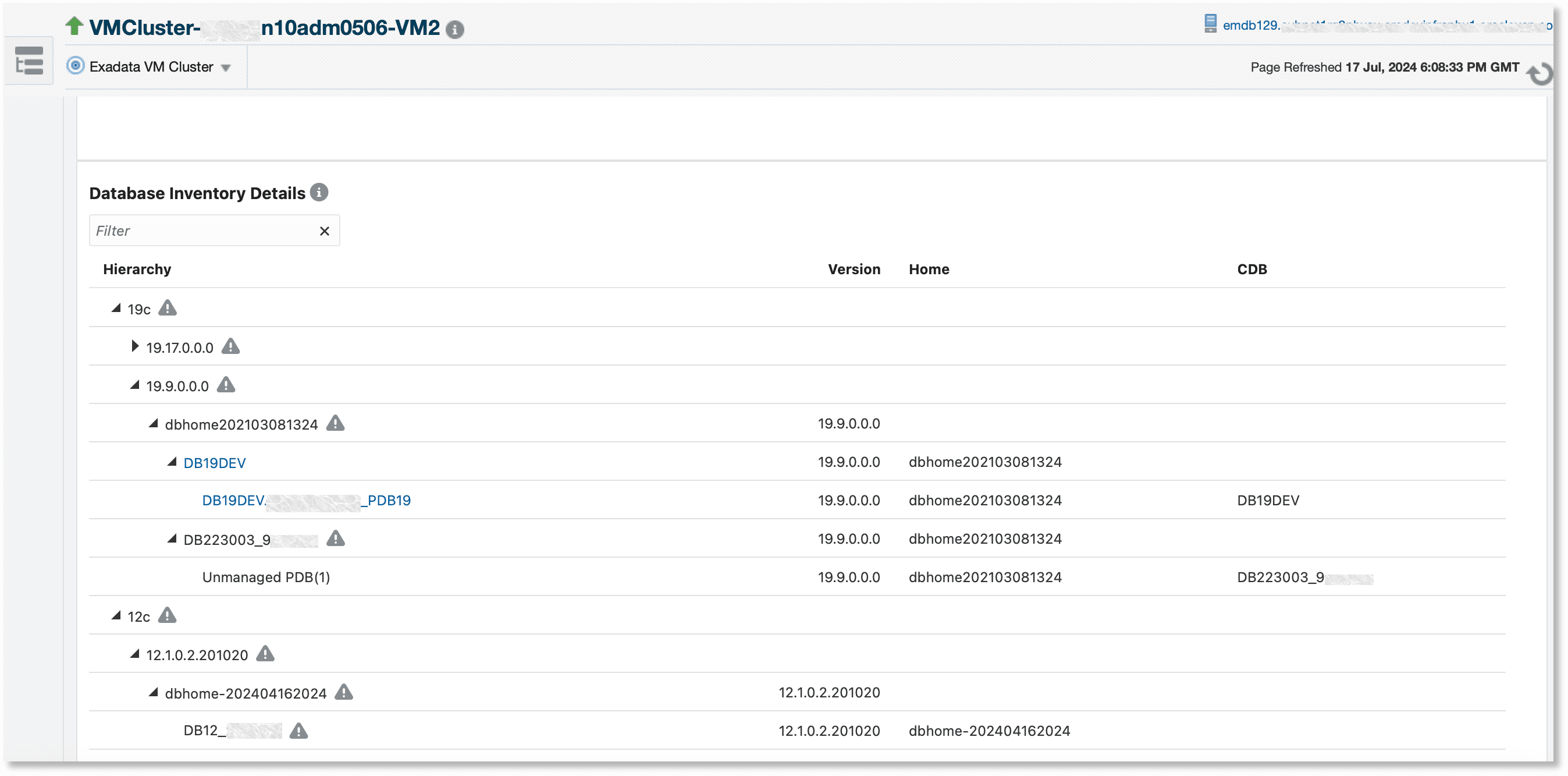Visualize Database Topology on Exadata VM Clusters
The VM Cluster target home page includes two additional database topology sections on the Databases tab when the Exadata Management Pack is enabled for the associated Exadata Infrastructure target:
- Database Inventory
- Database Inventory Details
Topics:
For steps to navigate to the VM Cluster home page, see Discover Exadata Cloud Targets in Oracle Enterprise Manager Cloud Control for Oracle Exadata Cloud.

Visualizing Database Inventory
The Database Inventory section of the Databases tab contains a Sankey diagram that traces the database topology of the VM cluster from the database versions at the root, through the Oracle homes, down to the aggregate counts of databases residing within the Oracle homes. The data for the resource hierarchy is obtained using Oracle Cloud Infrastructure REST API. See Manage VM Clusters in Exadata Database Service on Dedicated Infrastructure.
The following nodes and links are available in the Sankey diagram:
- Nodes: Each node represents a logical database classification:
- Major Database Version: Represents major releases of the Oracle Database; for example, versions 12c, 19c, 23ai, and so on.
- Minor Database Version: Represents Oracle Database release updates and patch levels within a major release; for example, 19.9.0.0.0, 12.1.0.2.2.
- Oracle Home: The installed Oracle home for software
binaries and related files for a specific database version; for example,
dbhome-2021, dbhome-2023.
For more information, see Create Oracle Database Homes on an Exadata Cloud Infrastructure System.
- Database/CDB Count: The aggregate number of container databases (CDBs) that can host pluggable databases (PDBs), or non-container databases, associated with their respective Oracle home. This count includes all the CDBs and non-CDBs on the VM cluster, even if they are not discovered in Oracle Enterprise Manager.
- PDB Count: The number of PDBs within the associated CDBs
- Links : Each link represents the relationship between the nodes it
connects. The width of the link is proportional to the count of components
associated with the link, so a thicker link indicates that there are more
components represented by the link.
- Initial link: Shows the total number of databases belonging to a particular major version
- Major Database Version to Minor Versions: Shows the relationship between major and minor versions of the Oracle Database
- Minor Database Version to Oracle Home: Shows the association of a specific version to the corresponding Oracle homes
- Oracle Home to Database/CDB Count: Shows the association of Oracle homes with the databases deployed in the homes
- CDB Count to PDB Count: Shows the relationship from the CDBs to the PDBs within each CDB
- Terminal link: Shows the count of PDBs, as deployed in Oracle Cloud
The diagram in the example below illustrates that there are a large number of databases with major version 19c as compared to databases with major version 12c, because the initial link for 19c is thicker. It also illustrates that two CDBs are associated to Oracle home dbhome-2021, and each CDB has one PDB associated with it.

Analyzing Database Inventory Details
Selecting individual nodes in the Sankey diagram described above interactively filters the table in the Database Inventory Details section, providing a more detailed analysis of specific sub-sections of the database topology. The table includes the following columns:
- Hierarchy: Represents the nested relationships of the major
database versions, minor versions, Oracle homes, databases/CDBs, and PDBs, as
applicable.
- The last one or two nodes in the hierarchy display the full
name of the database/CDB or PDB.
- If a database/CDB is discovered in EM, the name is hyper-linked to its home page.
- If a database/CDB is not discovered in EM, a warning icon is displayed next to its name indicating that the target is not managed in Oracle Enterprise Manager. All PDBs underneath such a CDB will be counted as unmanaged. The warning icon is bubbled up to its highest level ancestor in the hierarchy to help identify databases that are not monitored by Oracle Enterprise Manager.
- The filter applies to the Hierarchy column, and allows searches by sub-strings.
- The last one or two nodes in the hierarchy display the full
name of the database/CDB or PDB.
- Version: Represents the minor version of the respective Oracle home, database/CDB and PDBs shown in the row
- Home: Represents the Oracle home for the database, CDB or PDB shown in the row
- CDB: If the row corresponds to a PDB, this column shows the name of the corresponding CDB.
The example below illustrates the hierarchy when major version node 19c is expanded. This table complements the Sankey diagram by showing details of the two CDBs in the 19c version hierarchy. Since one CDB DB19DEV and its PDB DB19DEV_.._PDB19 are discovered in Oracle Enterprise Manager, links are provided to the respective home pages. Since the other CDB are not discovered, its PDB is shown as Unmanaged PDB(1).
